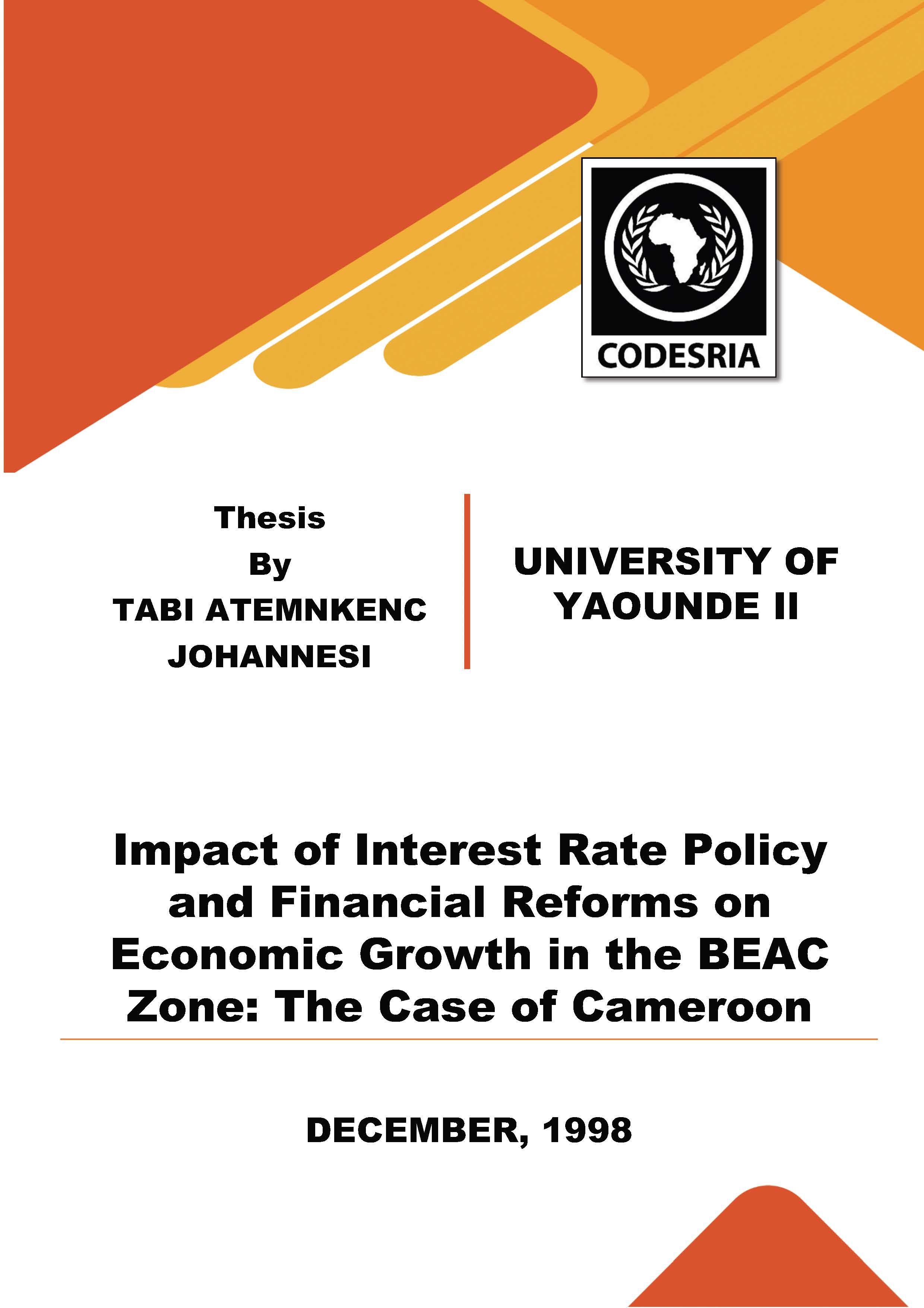Impact of Interest Rate Policy and Financial Reforms on Economic Growth in the BEAC Zone: The Case of Cameroon
Keywords:
Financial Reforms, Economic Growth, CameroonSynopsis
This study attempts to analyse the impact of interest rate policy on economic growth in Cameroon of the BEAC sub-region. lt covers the pe1iod before 1990 marked by negative real interest rates which symbolizes a repressed financial system and the 1990s characterised by positive real interest rates following the refom1s in the financial sector.
The study is based on the principle that the impact of interest rate and financial . reforms on growth works through the relationship that exists between savings and investment. As such savings and investment equations were also specified and estimated. An econometric switching model was used to estimate the growth and efficiency of investment equations. The model to be ve1ified holds that the eflkiency of investment will be negatively correlated with below-equilibrium interest rates and positively correlated with above-equilibrium rates. This implies economic growth should be positively correlated with below and above equilibrirnn interest rates respectively. This is because when the interest rate is held below equilibrium, 1ising investment compensates for falling efficiency of investment whereas at above equilibrium interest rates, falling investment due to high cost is offset by rising efficiency. The following results have been obtained.
Financial liberalisation theory holds that refom1ing the financial sector will lead to positive real deposit rates. This in turn; will raise the savings rate; increase financial deepening or bank liquidity; raiie the quantity and q11ality or investment thereby promoting economic growth. The empirical evidence for Cameroon still provides mild support tor the theory. Real interest rates are average!~ positive but the response of savings and the efficiency of investment are positive and insignificant whereas the quantity of investment, financial savings or bank liquidity and economic growth are negatively though insignificantly affected. However, there are indications that the refonns have been implemented in a period of relative macroeconomic instability and
unce11ainty which might have hindered the success of the reform. Fu1ihermore, some of the reforms are yet to be implemented (e.g. the creation of a stock market and Deposit guarantee scheme etc.).
At the level of the interest rate policy probably before the reform, real interest rate effectively influenced the flow of ftmds into the banking sector as real money balances are interest-elastic. The reason fix this could be that in a greater pati of the pre-reform period, the macroecoi'1omic and banking environment were stable and the favourable terms of trade might have generated much liquidity fron1· exports. However, despite the availability of fi.mds in the banking system, economic acti~ities declined, as· these funds were not made available to potential investors. This is reflected in the no:i-responsiveness of capital investment to real interest rates, as such the banking system is considered inefficient in Cameroon. Aggregate savings are also interest-inelastic but this may stem from the fact that the income effect dominates the substitution effect. That is, savings depend very much on income growth. The effect of the discount rate (real lending rate) on investment is positive and significant (insignificant). This may reflect the view that _the availability of fonds rather than the cost is imp01iant for investment decisions. And the net impact of real. deposit rate on economic growth is negative. In swn, the interest rate policy is
, ineffective. The existing structure of interest rates is economically insignificant and does not form the basis for moneta1y policy in Cameroon. Other factors· interplay in the growth process. The insignificant nature of interest rate movements resulted to an insignificant equilibrium rate which made it impossible to draw a conclusion or whether too low an interest. rate is detTimental to economic health as setting them to high. The hypothesis ought to be verified using a switching model as
mentioned above with an unknown obtah1ed suggests that the rate of equilibriwn interest rate. The model economic growth is negatively but insig11ificantly cortelated with below and above equilibrium interest rates respectively. This indicates the non-existence of a definable equilibrium interest rate in the empirical context of Carneroon.
Downloads
References
Alan, Griffiths and Stuart Wall ( 1997). Applied Economics: An Introductory Course. Addison Wesley Longman Limited.
Allen, ROG ( 1967). Macroeconomic themy. Macmillan Press Ltd, London and Basingstoke.
Campagna, Anthony S. (l 974). Macroeconomic theory and policy. Houghton Mifflin Company, U.S.A.
Carney, David (l 967). Patterns and Mechanics of Economic Growth: A General Theor.e tical Approach. The Antioch Press, U.S.A .
Chick, Victoria ( 1983 ). lvlacro Economics After Keynes: A Reconsideration of the General Theory. Philip Allan Publishers Limited, Oxford.
Clunies, Anthony Ross ( 1991 ). Economic Stabilization for Developing Countries. Edward Elgar Publishing Ltd, England.
Friend, Irwin (l 963f 'Determinants of the Volume and Consumption of Savings with special Reference to the Influence of MonetarYPolicy'. In, Impacts of the Monetary Policy Commission or Money and'Credit.
Englewood Cliffs, N. J. Pretice Hall.
Fry, Maxwell J. (l 988). Money, interest, and Banking in Economic Development. Baltimore: The Johns Hopkins University Press.
Fry, Maxwell J ., Charles A.E. Goodhart & Alvaro Almeida ( 1996). Central Banking in Developing Countries; Foreword by Eddie George, Governor of the Bank of England. London and New York, Routledge.
Goldfeld, Stephen M. and Richard E. Quandt (1976). Studies in Non Linear Estimation. Ballinger Publishing Company - Cambridge, Mass.
Keynes, John Maynard (l 936). The General theory of Employment, Interest. and Money. London: Macmillan.






